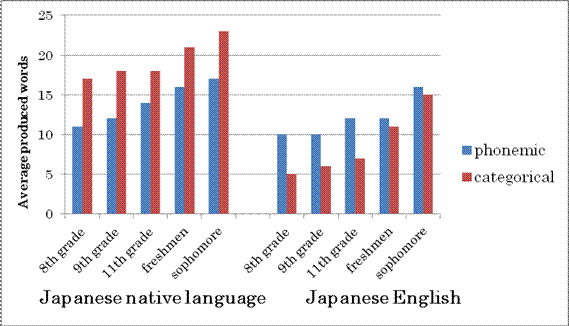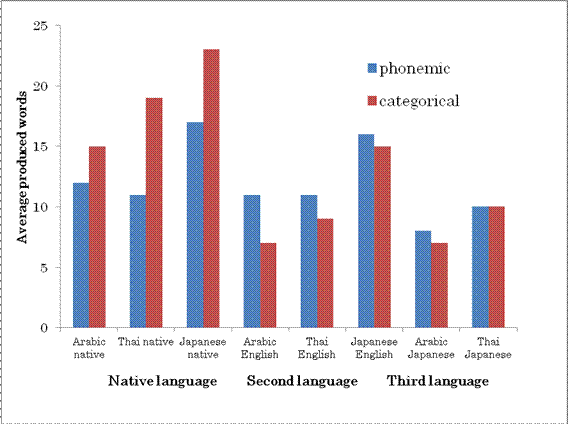
Fig.1 Average produced words by different developmental levels of Japanese native speakers and their second language of English
Keiko Asano- keiko_asano@sakura.juntendo.ac.jp
School of Medicine, Department of Liberal Arts
Juntendo University
1-1 Hiragagakuendai, Inzai-city, Chiba-Pref.
Zip 270-1695, Japan
Popular Version of paper Session 4aPP3
Presented Session Thursday morning, November 3, 2011
162nd ASA Meeting, San Diego, Calif.
Introduction:
Acquisition of second (third) languages for learners is known as the integration of 4 total skills learning: Listening, Reading, Speaking and Writing. In order to improve their language skills, increasing the vocabulary knowledge becomes the core role of learning total skills processes. Even for growing the knowledge of native language, enhancing the number of words is very important. In this research, Verbal Fluency Test is applied and conducted to examine how native speakers and second (third) language learners produce words orally.
Method:
“How many numbers of words can you orally produce within a minute?” This question we ask to participants is very simple. However, the mechanism of producing words may not be as simple as the question goes. This simple task question is called Verbal Fluency Test, which is commonly used in clinical and neuropsychological assessments for checking language and frontal lobe function of Parkinson’s disease, epilepsy, or dementia suffers. The most frequently used score from this Test is quantitative information such as the total number of words the participants produced. In terms of the assessment for competence of vocabulary, the Test was applied and conducted to Arabic, Thai, and Japanese native speakers and their second (third) language learners. This Test is consisted on two different tasks: phonemic and categorical sections. As for phonemic verbal fluency test procedure, the participants were to produce orally as many different words as possible beginning with the given letter such as “S” within a minute. In terms of categorical verbal fluency test, assigned item’s names such as “animals” were asked to produce also within a minute. In the clinical field, these produced words’ scores are only adopted to use as quantitative information. However, in this study, the relationship between the phonemic and categorical sections is also analyzed as the ability of second (third) language learners’ oral word production.
Results:
In my previous research (Asano 2011a),143 native speakers of Japanese with English as their second language participated in this experiment. They were divided by 5 groups through 8th grade in high school to sophomore in university according to their different developmental levels. Fig. 1 shows that average number of English and Japanese words produced both phonemic and categorical verbal fluency among these groups. The results shows that the older and the more the participants learn English as second language, the more they can produce words, even as for their native language. It is commonly known that normal and healthy native speakers can produce more words in categorical section than that of in phonemic one while the clinically disorders’ results are reversed. Then why did all the Japanese participants produce less in categorical sections of English version which is their second language. Are these results specific only for Japanese second language learners of English? To take a close look at the result, next test was conduced to different languages participants such as Arabic, and Thai.

Fig.1 Average produced words by different developmental levels of Japanese native speakers and their second language of English
Fig. 2 shows that 24 Japanese, 12 Arabic and 10 Thai native speakers produced more words in categorical section, which is the same result from Fig. 1. Even Japanese language stated as the third language for Arabic and Thai participants, the numbers of average produced words are relatively less in phonemic section. It is the same result as their second language produced words.

Fig.2 Average produced words by Japanese, Arabic, Thai native speakers and their second (third) language
Discussion:
Phonemic and categorical verbal fluency tests were conducted to three different kinds of languages’ native speakers and their second (third) language learners. The categorical items of words are produced more than phonemic assigned words among all of three native languages participants. There is a prediction that people may have to use different brain areas and neuron circuits when they are conducted to these two fluency tasks: “inferior frontal cortex and temporoparietal cortex were activated more during phonemic than categorical task, whereas left temporal cortex were activated more during categorical than phonemic fluency task” (Gourovitch et. al. 2000). Moreover, in terms of the process of producing words, it may be suggested that second (third) language learners use other strategies compared with that of native speakers do. There may be another assumption that if second (third) language learners learn more, their words production pattern in both of 2 fluency tasks become closer to that of native speakers’.
Further studies will be focused on the qualitative information such as the way how words are categorized using the methods of clustering and switching during the words production.